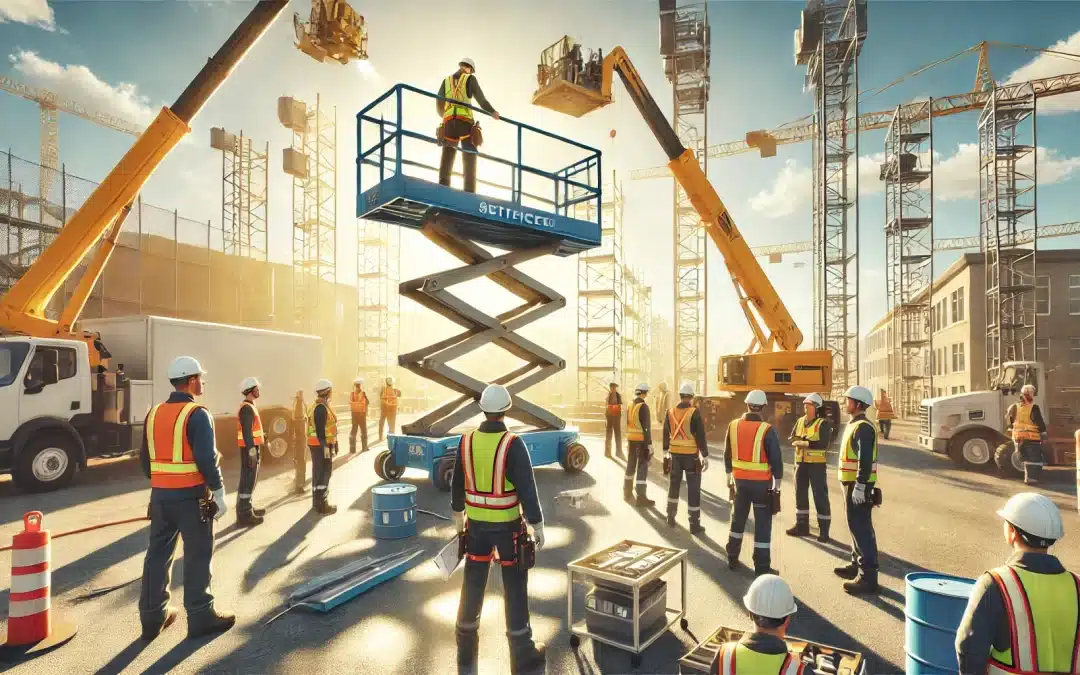In Canada, working on aerial work platforms (AWPs) is a common task in various industries, from construction to maintenance and beyond. These platforms, also known as aerial lifts, provide access to high and hard-to-reach areas, making tasks safer and more efficient. However, operating an AWP is not without risks, which is why proper training and certification are essential. This article will delve into the certification requirements for aerial work platforms in Canada, ensuring you understand the training, safety protocols, and legal mandates necessary for safe and compliant operations.
Why Aerial Work Platform Certification Matters
Safety should always be a top priority when working with AWPs. The certification process ensures that operators are well-equipped to handle these machines safely and efficiently.
Importance of Certification:
- Legal Compliance: Adhering to Canadian regulations regarding aerial lift operations is mandatory. Certification ensures compliance with these laws.
- Enhanced Safety: Proper training minimizes the risk of accidents and injuries, protecting both operators and those around them.
- Operational Efficiency: Certified operators are more competent, leading to improved productivity and fewer operational hiccups.
- Insurance and Liability: Certification can reduce liability in the event of an accident and may be required by insurance providers.
Aerial Work Platform Training Requirements in Canada
In Canada, aerial work platform training is governed by both federal and provincial regulations. The goal is to ensure that all operators possess the necessary knowledge and skills to operate AWPs safely.
Federal Regulations:
The Canadian Centre for Occupational Health and Safety (CCOHS) provides guidelines for safe operation. Training programs must comply with these standards, covering topics such as equipment inspection, safe operation practices, and emergency procedures.
Provincial Regulations:
Each province may have additional requirements. For instance, in Ontario, the Occupational Health and Safety Act (OHSA) outlines specific training requirements for operators of elevating work platforms.
Training Requirements:
- Theoretical Training: Covers the principles of AWP operation, safety protocols, and legal requirements.
- Practical Training: Hands-on training under the supervision of a qualified instructor, allowing operators to practice and demonstrate their skills.
- Evaluation: Both written and practical tests to assess the operator’s knowledge and competence.
Key Components of an Aerial Work Platform Course
A comprehensive AWP training course should cover several key components to ensure operators are fully prepared for the job.
-
Equipment Familiarization:
Operators must understand the different types of aerial work platforms, including scissor lifts, boom lifts, and vertical mast lifts. Training should cover the specific functions and limitations of each type.
-
Pre-Operation Inspections:
Training should include how to conduct thorough pre-operation inspections. This involves checking the machine’s physical condition, verifying that safety devices are operational, and ensuring there are no obvious defects.
-
Safe Operation Practices:
Operators must learn the best practices for safe operation. This includes understanding load limits, proper positioning of the platform, avoiding overhead hazards, and operating the lift on stable ground.
-
Emergency Procedures:
In case of an emergency, operators must know how to safely lower the platform, shut down the equipment, and respond to incidents. This training includes familiarization with emergency controls and rescue procedures.
-
Fall Protection:
Fall protection is a critical aspect of working at heights. Training must cover the proper use of personal protective equipment (PPE), harnesses, and guardrails to prevent falls.
AWP Safety Best Practices
Safety is paramount when operating aerial work platforms. Following best practices can significantly reduce the risk of accidents and injuries.
Conduct Regular Inspections:
Perform daily inspections of the AWP before use. Check for any signs of wear and tear, ensure all controls are functioning correctly, and verify that safety devices are operational.
Use Personal Protective Equipment (PPE):
Always wear appropriate PPE, including a hard hat, safety harness, and non-slip footwear. Ensure that harnesses are properly secured and attached to designated anchor points.
Maintain Clear Communication:
Ensure clear communication among all team members. Use hand signals or communication devices to coordinate movements and signal emergencies.
Avoid Overloading:
Never exceed the platform’s load capacity. Overloading can lead to tip-overs and structural failure. Be mindful of the weight of tools and materials being carried.
Stay Aware of Surroundings:
Be aware of your surroundings at all times. Avoid overhead obstacles, power lines, and uneven surfaces. Ensure the ground is stable and level before operating the lift.
Certification Process and Validity
The certification process for aerial work platforms involves several steps to ensure that operators are competent and compliant with safety regulations.
Steps to Certification:
- Enroll in a Certified Training Program: Choose a program that complies with federal and provincial regulations.
- Complete Theoretical Training: Learn the principles of AWP operation, safety protocols, and legal requirements.
- Participate in Practical Training: Gain hands-on experience under the supervision of a qualified instructor.
- Pass the Evaluation: Successfully complete both written and practical tests to demonstrate your knowledge and skills.
- Receive Certification: Upon passing the evaluation, you will receive your AWP certification.
Certification Validity:
Certification typically remains valid for a specified period, often three to five years. After this period, operators must undergo refresher training and re-certification to ensure they remain up-to-date with current safety practices and regulations.
Final Thoughts
Aerial work platform certification is not just a regulatory requirement—it’s a crucial component of workplace safety. Proper training ensures that operators can handle AWPs safely, efficiently, and in compliance with Canadian regulations. This enhances overall safety, operational efficiency, and legal compliance, benefiting both the operators and their employers.
At Valley WorkSafe, we specialize in workplace safety training for clients located in Renfrew County and Ottawa Valley. If you’re not located in our area, our online certificate course for Aerial Work Platform (AWP) Certification is a great way to prepare yourself for working at heights, and in aerial platform environments. They’re easy to access and can be completed in under a day from the comfort of your home, or workplace laptop. By investing in this training, you not only ensure compliance with safety regulations but also enhance your resume and career prospects. Certified operators often earn more, stand out in job searches, and are more likely to receive promotions. Don’t wait—get certified today and take the first step towards a safer, more rewarding career.
Watch Our Safety Video here: https://www.youtube.com/@valleyworksafe/



